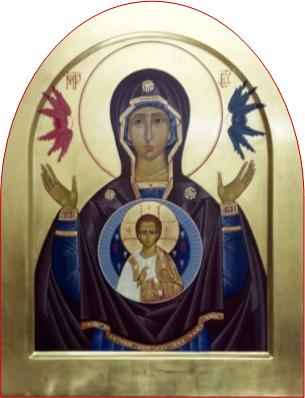Eikona

The word ICON comes from the Ancient Greek word EIKONA (image, likeness, portrait). Since the early centuries of Christianity, the word "icon" was used to refer to images with a religious content, meaning and use. Christian art first appeared in the catacombs. When Christianity was recognized as a state religion in the 4th Century, Christian art left the catacombs along with the pagan symbols and were replaced with icons. Icons became part of the Church's preaching and part of the Church's prayer. The Orthodox Church is a Church of tradition, and the presence and use of icons in the church is a reflection of this tradition. Icons have important roles in the church's worship and in personal devotion: Icons teach, sanctify, and unite. Icons are an instrument for the transmission of Christian faith and an aid to worship. Icons allow us a glimpse of the Kingdom of God, a vision of the Word of God (the LOGOS) in human form. Christ is "the image of the invisible God" (Col. 1:15). Because Christ is God who became Man, He can Himself be pictured or imaged. Thus, icons of Christ, the Theotokos - together with those of the Saints and scenes from the Bible - express the reality of the Incarnation. The Orthodox Church uses icons for veneration (but never worship them, for worship is due to God alone) with the understanding that the respect is paid not to the material icon but to the person represented "in spirit and truth" (John 4: 24). The Holy Spirit speaks to men through icons. Anywhere an icon is placed, a place of worship and prayer is set. The icon is theology in images and color. Tradition identifies St. Luke as the first iconographer. He wrote the first icon of the Most Holy Theotokos, as well as icons of the Holy Apostles Peter and Paul.
Eikona
Le mot ICON vient du grec ancien EIKONA (image, portrait). Dès les premiers siècles du christianisme, le mot « icône » a été utilisé pour désigner des images ayant un contenu, une signification et un usage religieux. L’art chrétien est apparu pour la première fois dans les catacombes. Lorsque le christianisme fut reconnu comme religion d’État au 4e siècle, l’art chrétien quitta les catacombes et les symboles païens furent remplacés par les icônes. La vénération des icônes est, dans l’Église orthodoxe, un dogme de foi : les icônes sont vénérées, mais non adorées, car l’adoration n’est due qu’à Dieu seul, étant entendu que le respect n’est pas porté à l’icône matérielle, mais à la personne représentée « en esprit et en vérité » (Jn 4, 24). L’icône constitue un aspect essentiel de l’expérience liturgique, c’est-à-dire de la contemplation du Royaume. Les icônes jouent un rôle important dans le culte liturgique et dans la dévotion personnelle : elles enseignent, sanctifient et unissent. Elles sont un instrument de transmission de la foi et une aide au culte. L’icône transforme la vue en vision : car Dieu ne S’est pas seulement fait entendre, Il s’est fait voir, la gloire de la Trinité s’est révélée à travers la chair du Fils de l’Homme. Le Christ n’est pas seulement le Verbe de Dieu (le Logos), mais Son image, « l’image du Dieu invisible » (Col 1, 15). Parce que Christ est Dieu qui est devenu homme, il peut être lui-même représenté. L’Incarnation du Verbe est l’acte fondateur de l’icône et l’icône témoigne de l’Incarnation. Le Saint-Esprit parle aux hommes à travers les icônes. L’icône est donc une théologie en images et en couleurs. La Tradition identifie Saint-Luc comme le premier iconographe. Il a écrit la première icône de la Mère de Dieu, ainsi que des icônes des saints apôtres Pierre et Paul.